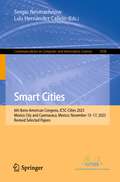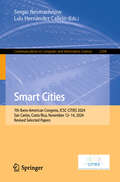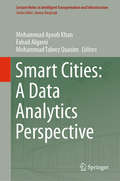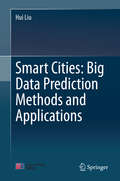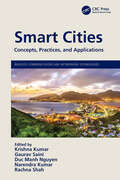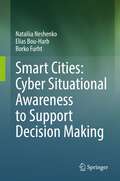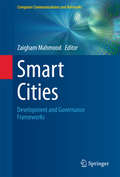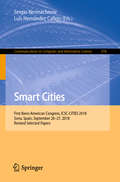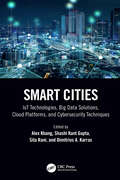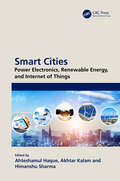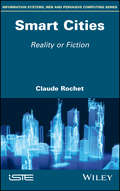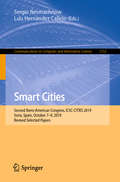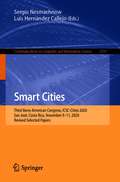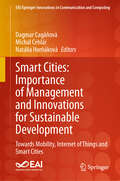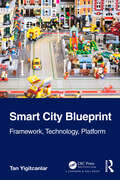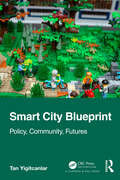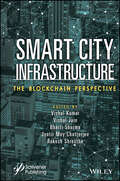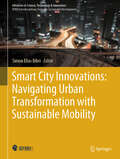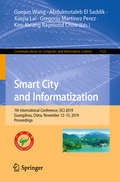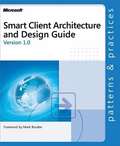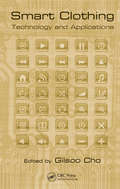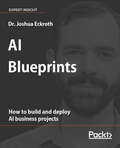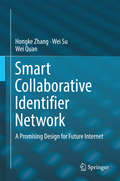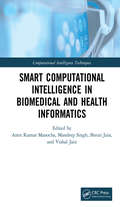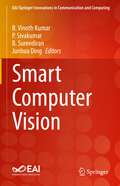- Table View
- List View
Smart Cities: 6th Ibero-American Congress, ICSC-Cities 2023, Mexico City and Cuernavaca, Mexico, November 13–17, 2023, Revised Selected Papers (Communications in Computer and Information Science #1938)
by Sergio Nesmachnow Luis Hernández CallejoThis book constitutes the revised selected papers of the 6th Ibero-American Congress on Smart Cities, ICSC-Cities 2023, held in Mexico City and Cuernavaca, Mexico, during November 13–17, 2023. The 19 full papers included in this book were carefully reviewed and selected from 94 submissions. They were organized in topical sections as follows: Urban Informatics for Smart Cities; Optimization, Smart Industry, and Smart Public Services; Internet of Things; Computational Intelligence and Urban Informatics for Smart Cities and Innovative Informatic Approaches for Smart Cities.
Smart Cities: 7th Ibero-American Congress, ICSC-CITIES 2024, San Carlos, Costa Rica, November 12–14, 2024, Revised Selected Papers (Communications in Computer and Information Science #2394)
by Sergio Nesmachnow Luis Hernández CallejoThis book constitutes the revised selected papers of the 7th Ibero-American Congress on Smart Cities, ICSC-Cities 2024, held in San Carlos, Costa Rica during November 12–14, 2024. The 24 full papers included in this book were carefully reviewed and selected from 129 submissions. They were organized in topical sections as follows: Internet of Things and Big Data; Computational intelligence for smart cities; Optimization, smart industry, and smart public services; Innovative approaches for smart cities; Control strategies for smart grid.
Smart Cities: A Data Analytics Perspective (Lecture Notes in Intelligent Transportation and Infrastructure)
by Mohammad Ayoub Khan Mohammad Tabrez Quasim Fahad AlgarniThis book offers practical as well as conceptual knowledge of the latest trends, tools, techniques and methodologies of data analytics in smart cities. The smart city is an advanced technological area that is capable of understanding the environment by examining the data to improve the livability. The smart cities allow different kinds of wireless sensors to gather massive amounts, full speed and a broad range of city data. The smart city has a focus on data analytics facilitated through the IoT platforms. There is a need to customize the IoT architecture and infrastructures to address needs in application of specific domains of smart cities such as transportation, traffic, health and, environment. The smart cities will provide next generation development technologies for urbanization that includes the need of environmental sustainability, personalization, mobility, optimum energy utilization, better administrative services and higher quality of life. Each chapter presents the reader with an in-depth investigation regarding the possibility of data analytics perspective in smart cities. The book presents cutting-edge and future perspectives of smart cities, where industry experts, scientists, and scholars exchange ideas and experience about surrounding frontier technologies, breakthrough and innovative solutions and applications.
Smart Cities: Big Data Prediction Methods and Applications
by Hui LiuSmart Cities: Big Data Prediction Methods and Applications is the first reference to provide a comprehensive overview of smart cities with the latest big data predicting techniques. This timely book discusses big data forecasting for smart cities. It introduces big data forecasting techniques for the key aspects (e.g., traffic, environment, building energy, green grid, etc.) of smart cities, and explores three key areas that can be improved using big data prediction: grid energy, road traffic networks and environmental health in smart cities. The big data prediction methods proposed in this book are highly significant in terms of the planning, construction, management, control and development of green and smart cities. Including numerous case studies to explain each method and model, this easy-to-understand book appeals to scientists, engineers, college students, postgraduates, teachers and managers from various fields of artificial intelligence, smart cities, smart grid, intelligent traffic systems, intelligent environments and big data computing.
Smart Cities: Concepts, Practices, and Applications (Wireless Communications and Networking Technologies)
by Krishna Kumar Narendra Kumar Gaurav Saini Duc Manh Nguyen Rachna ShahThis book discusses the various aspects of smart cities and their architecture along with the application of the latest technologies, including the Internet of Things (IoT) and artificial intelligence (AI). The concept of smart cities, their development, technological advancements, and issues related to them are discussed in detail.Smart Cities: Concepts, Practices, and Applications covers numerous topics, including energy utilities and the role of renewable energy for sustainable development, intelligent transport systems, traffic management, sewage and waste management, the impact of smart city development on the social and economic aspects of life, flexible communication technologies utilized in the development of smart cities, e-governance challenges, and implementation in smart cities.FEATURES Discusses the basic architecture of a smart city and its development concept Covers the application of IoT and AI in the development of smart cities Examines the impact of smart city development on social and economic aspects Presents comprehensively intelligent transport systems and traffic management This book will be useful for senior undergraduate and graduate students and professionals in electrical engineering, electronics and communication engineering, computer science, and civil engineering.
Smart Cities: Cyber Situational Awareness to Support Decision Making
by Borko Furht Elias Bou-Harb Nataliia NeshenkoThis book overviews the drivers behind the smart city vision, describes its dimensions and introduces the reference architecture. It further enumerates and classifies threats targeting the smart city concept, links corresponding attacks, and traces the impact of these threats on operations, society and the environment. This book also introduces analytics-driven situational awareness, provides an overview of the respective solutions and highlights the prevalent limitations of these methods. The research agenda derived from the study emphasizes the demand and challenges for developing holistic approaches to transition these methods to practice equipping the user with extensive knowledge regarding the detected attack instead of a sole indicator of ongoing malicious events. It introduces a cyber-situational awareness framework that can be integrated into smart city operations to provide timely evidence-based insights regarding cyber incidents and respective system responses to assist decision-making. This book targets researchers working in cybersecurity as well as advanced-level computer science students focused on this field. Cybersecurity operators will also find this book useful as a reference guide.
Smart Cities: Development And Governance Frameworks (Computer Communications and Networks)
by Zaigham MahmoodThis invaluable text/reference investigates the state of the art in approaches to building, monitoring, managing, and governing smart cities. A particular focus is placed on the distributed computing environments within the infrastructure of such cities, including issues of device connectivity, communication, security, and interoperability. A selection of experts of international repute offer their perspectives on current trends and best practices, and their suggestions for future developments, together with case studies supporting the vision of smart cities based on the Internet of Things (IoT).Topics and features: examines the various methodologies relating to next-level urbanization, including approaches to security and privacy relating to social and legal aspects; describes a recursive and layered approach to modeling large-scale resource management systems for self-sustainable cities; proposes a novel architecture for hybrid vehicular wireless sensor networks, and a pricing mechanism for the management of natural resources; discusses the challenges and potential solutions to building smart city surveillance systems, applying knowledge-based governance, and adopting electric vehicles; covers topics on intelligent distributed systems, IoT, fog computing paradigms, big data management and analytics, and smart grids; reviews issues of sustainability in the design of smart cities and healthcare services, illustrated by case studies taken from cities in Japan, India, and Brazil.This illuminating volume offers a comprehensive reference for researchers investigating smart cities and the IoT, students interested in the distributed computing technologies used by smart living systems, and practitioners wishing to adopt the latest security and connectivity techniques in smart city environments.
Smart Cities: First Ibero-American Congress, ICSC-CITIES 2018, Soria, Spain, September 26–27, 2018, Revised Selected Papers (Communications in Computer and Information Science #978)
by Sergio Nesmachnow Luis Hernández CallejoThis book constitutes the thoroughly refereed proceedings of the First Ibero-American Congress, ICSC-CITIES 2018, held in Soria, Spain, in May 2018. The 15 full papers presented were carefully reviewed and selected from 101 submissions. The papers cover wide research fields including smart cities, energy efficiency and sustainability, infrastructures, smart mobility, intelligent transportation systems, Internet of Things, governance and citizenship.
Smart Cities: IoT Technologies, Big Data Solutions, Cloud Platforms, and Cybersecurity Techniques
by Alex Khang Sita Rani Shashi Kant Gupta Dimitrios A. KarrasThis book discusses the basic principles of sustainable development in a smart city ecosystem to better serve the life of citizens. It examines smart city systems driven by emerging IoT-powered technologies and the other dependent platforms. Smart Cities: AI, IoT Technologies, Big Data Solutions, Cloud Platforms, and Cybersecurity Techniques discusses the design and implementation of the core components of the smart city ecosystem. The editors discuss the effective management and development of smart city infrastructures, starting with planning and integrating complex models and diverse frameworks into an ecosystem. Specifically the chapters examine the core infrastructure elements, including activities of the public and private services as well as innovative ICT solutions, computer vision, IoT technologies, data tools, cloud services, AR/VR technologies, cybersecurity techniques, treatment solution of the environmental water pollution, and other intelligent devices for supporting sustainable living in the smart environment. The chapters also discuss machine vision models and implementation as well as real-time robotic applications. Upon reading the book, users will be able to handle the challenges and improvements of security for smart systems, and will have the know-how to analyze and visualize data using big data tools and visualization applications. The book will provide the technologies, solutions as well as designs of smart cities with advanced tools and techniques for students, researchers, engineers, and academics.
Smart Cities: Power Electronics, Renewable Energy, and Internet of Things
by Himanshu Sharma Akhtar Kalam Ahteshamul HaqueThis book discusses the integration of power electronics, renewable energy, and the Internet of Things (IoT) from the perspective of smart cities in a single volume. The text will be helpful for senior undergraduate, graduate students and academic researchers in diverse engineering fields including electrical, electronics and communication, and computers. The book: Covers the integration of power electronics, energy harvesting, and the IoT for smart city applications. Discusses concepts of power electronics and the IoT in electric vehicles for smart cities. Examines the integration of power electronics in renewable energy for smart cities. Discusses important concepts of energy harvesting including solar energy harvesting, maximum power point tracking (MPPT) controllers, and switch-mode power supplies (SMPS). Explores IoT connectivity technologies such as long-term evolution (LTE), narrow band NB-IoT, long-range (LoRa), Bluetooth, and ZigBee (IEEE Standard 802.15.4) for low data rate wireless personal communication applications. The text provides the knowledge about applications, technologies, and standards of power electronics, renewable energy, and IoT for smart cities. It will serve as an ideal reference text for senior undergraduate, graduate students and academic researchers in the fields of electrical engineering, electronics and communication engineering, computer engineering, civil engineering, and environmental engineering.
Smart Cities: Reality or Fiction
by Claude RochetThe intelligence of a city is the capacity to learn: to learn the past, its history and the culture of its territory. Unlike the smart city, we do not build a city from scratch and there is nothing, there is no smart city standard car intelligence is measured this ability to fit into a territorial dynamic, a story and a culture. Continuous learning through instantaneous feedback provides the digital to understand and map the urban system and driver.
Smart Cities: Second Ibero-American Congress, ICSC-CITIES 2019, Soria, Spain, October 7–9, 2019, Revised Selected Papers (Communications in Computer and Information Science #1152)
by Sergio Nesmachnow Luis Hernández CallejoThis book constitutes the thoroughly refereed proceedings of the Second Ibero-American Congress, ICSC-CITIES 2019, held in Soria, Spain, in October 2019. The 22 full papers presented were carefully reviewed and selected from 98 submissions. The papers focus on Energy Efficiency and Sustainability; Infrastructures, Energy and the Environment; Mobility and Internet of Things; and Governance and Citizenship.
Smart Cities: Third Ibero-American Congress, ICSC-Cities 2020, San José, Costa Rica, November 9-11, 2020, Revised Selected Papers (Communications in Computer and Information Science #1359)
by Sergio Nesmachnow Luis Hernández CallejoThis book constitutes the thoroughly refereed proceedings of the Third Ibero-American Congress, ICSC-CITIES 2020, held in Costa Rica, in November 2020. Due to the COVID-19 pandemic the conference was held online. The 21 full papers presented were carefully reviewed and selected from 99 submissions. The papers are organized on topical sections on Energy Efficiency and Sustainability; Mobility and IoT; Infrastructure, Environment, Governance.
Smart Cities: Towards Mobility, Internet of Things and Smart Cities (EAI/Springer Innovations in Communication and Computing)
by Dagmar Cagáňová Natália Horňáková Michal CehlárThis book features contributions focusing on innovative technologies influencing industry and connectivity sectors in industrial, urban, social and sustainable development. The contributions cover many topics in mobility, including car manufacturing, e-mobility, smart cities, smart factories (Industry 4.0), smart logistics, social mobility, technological innovations, sustainability, management and marketing, multicultural development, Internet of Things sectors, etc. The contributions are applicable to researchers, academics, students, and professionals.
Smart City Blueprint: Framework, Technology, Platform
by Tan YigitcanlarThe smart city movement, during the last decade and a half, advocated the built environment and digital technology convergence with the backing of institutional capital and government support. The commitment of a significant number of local governments across the globe, in terms of official smart city policies and initiatives, along with the constant push of global technology giants, has reinforced the popularity of this movement. This two-volume treatment on smart cities thoroughly explores and sheds light on the prominent elements of the smart city phenomenon and generates a smart city blueprint. This first volume, with its 12 chapters, provides a sound understanding on the key foundations and growth directions of smart city frameworks, technologies, and platforms, with theoretical expansions, practical implications, and real-world case study lessons. The second companion volume offers sophisticated perspectives on the key foundations and directions of smart city policies, communities, and urban futures, with theoretical expansions, practical implications, and real-world case study lessons. This book is an invaluable reference source for urban policymakers, managers, planners, practitioners, and many others, particularly to benefit from it when tackling key urban and societal issues and planning for and delivering smart city solutions. Moreover, the book is also a rich and important repository for scholars and research and undergraduate students as it communicates the complex smart city phenomenon in an easy to digest form, by providing both the big picture view and specifics of each component of that view. It also appeals to local government agencies and smart city practitioners.
Smart City Blueprint: Policy, Community, Futures
by Tan YigitcanlarThe smart city movement, during the last decade and a half, advocated the built environment and digital technology convergence with the backing of institutional capital and government support. The commitment of a significant number of local governments across the globe, in terms of official smart city policies and initiatives, along with the constant push of global technology giants, has reinforced the popularity of this movement. This two-volume treatment on smart cities thoroughly explores and sheds light on the prominent elements of the smart city phenomenon and generates a smart city blueprint. The first volume, with its 12 chapters, provides a sound understanding on the key foundations and growth directions of smart city frameworks, technologies, and platforms, with theoretical expansions, practical implications, and real-world case study lessons. The second companion volume offers sophisticated perspectives on the key foundations and directions of smart city policies, communities, and urban futures, with theoretical expansions, practical implications, and real-world case study lessons. These volumes offer an invaluable reference source for urban policymakers, managers, planners, practitioners, and many others, particularly to benefit from it when tackling key urban and societal issues and planning for and delivering smart city solutions. Moreover, the book is also a rich and important repository for scholars and research and undergraduate students.
Smart City Infrastructure: The Blockchain Perspective
by Jyotir Moy Chatterjee Vishal Jain Rakesh Shrestha Vishal Kumar Bharti SharmaSMART CITY INFRASTRUCTURE The wide range of topics presented in this book have been chosen to provide the reader with a better understanding of smart cities integrated with AI and blockchain and related security issues. The goal of this book is to provide detailed, in-depth information on the state-of-the-art architecture and infrastructure used to develop smart cities using the Internet of Things (IoT), artificial intelligence (AI), and blockchain security—the key technologies of the fourth industrial revolution. The book outlines the theoretical concepts, experimental studies, and various smart city applications that create value for inhabitants of urban areas. Several issues that have arisen with the advent of smart cities and novel solutions to resolve these issues are presented. The IoT along with the integration of blockchain and AI provides efficient, safe, secure, and transparent ways to solve different types of social, governmental, and demographic issues in the dynamic urban environment. A top-down strategy is adopted to introduce the architecture, infrastructure, features, and security. Audience The core audience is researchers in artificial intelligence, information technology, electronic and electrical engineering, systems engineering, industrial engineering as well as government and city planners.
Smart City Innovations: Navigating Urban Transformation with Sustainable Mobility (Advances in Science, Technology & Innovation)
by Simon Elias BibriThis book offers a comprehensive exploration of the intersection of urban planning, transportation, technology, and smart city development. With a keen focus on sustainability and the potential for positive change, it presents a collection of diverse chapters that shed light on emerging trends and innovative solutions in the field. The book examines the role of urban ropeways as both a public transport service and a catalyst for touristic development, highlighting their potential benefits and challenges. It also introduces novel approaches to measuring accessibility and transportation potential using Space Syntax and Geographic Information Systems (GIS), providing valuable insights for urban planners and policymakers. The chapters delve into specific areas of study, such as the driving behavior of individuals with high-functioning autism spectrum disorder, the mobility challenges faced by women in developing countries, and alternative methods of snow and ice removal in parkingareas through hydronic heating. Furthermore, the book explores the intersection of sustainability, smart cities, and global travel, considering the impact of aviation on climate change and the potential of digital humanism in the metaverse. It also examines the implications and challenges of cultural biases in smart city development, emphasizing the need for inclusive and culturally sensitive approaches. The integration of Internet of Things (IoT) in housing is discussed, focusing on the domotization of sustainable walls and their potential benefits for energy efficiency and sustainable living. The use of immersive technologies in virtual heritage is explored, showcasing innovative tourist experiences and highlighting the case of the Berati Ethnographic Museum. The book also addresses the potential of web mapping applications for smart city development, the behavioral attitudes toward ridesharing and mode preferences of shared automated electric vehicles, the development of wind turbine systems for vehicle battery recharging, and the application of knowledge-driven problem identification in transformative city design and development. “Smart City Innovations" serves as a valuable resource for researchers, professionals, policymakers, and anyone interested in the future of urban planning, transportation, and smart cities. By addressing pressing challenges and presenting innovative solutions, this book aims to inspire positive change and contribute to the creation of sustainable and livable urban environments.
Smart City and Informatization: 7th International Conference, iSCI 2019, Guangzhou, China, November 12–15, 2019, Proceedings (Communications in Computer and Information Science #1122)
by Abdulmotaleb El Saddik Guojun Wang Gregorio Martinez Perez Kim-Kwang Raymond Choo Xuejia LaiThis book constitutes the refereed proceedings of the 7th International Conference on Smart City and Informatization, iSCI 2019, held in Guangzhou, China, in November 2019.The volume presents 52 full papers, which were carefully reviewed and selected from 139 submissions. The papers are organized in topical sections on Internet of Things (IoT) and smart sensing; urban computing and big data; smart society informatization technologies; cloud/edge/fog computing for smart city; applications for smart city informatization; assistive engineering and information technology; cyberspace security; blockchain and applications.
Smart Client Architecture and Design Guide
by Microsoft CorporationGet expert, pragmatic guidance on how to design and build smart client solutions that combine the benefits of traditional, rich-client applications with the manageability of thin clients. Software architects and developers will learn how to evaluate whether a smart client solution is appropriate for their client architecture, and get practical recommendations on how to deal with the design and technical challenges associated with building smart clients solutions using Microsoft® Windows® Forms technology in the Microsoft .NET Framework. Topics include handling data, connecting to the back end, offline functionality, security features, multithreading, deployment, and performance. PATTERNS & PRACTICES guides are reviewed and approved by Microsoft engineering teams, consultants, partners, and customers--delivering accurate, real-world information that's been technically validated and tested.
Smart Clothing: Technology and Applications (Human Factors and Ergonomics)
by Gilsoo ChoGPS-embedded clothing for finding children or skiers when they are lost, bio-monitoring smart shirts, and vests that monitor a patient's vital signs are no longer science fiction but science fact. It is quite likely that within 20 or 30 years, computers, telephones, and televisions will be a part of our intimate clothing. Covering the whole design
Smart Code
by Joshua EckrothSmart Code can be read and understood by programmers and students without practical AI experience, since it is meant as an introduction to AI in practice. By the same token, some AI technical reading or AI algorithm implementation experience would be most welcome, whether as part of an undergraduate or a business software project. Further, knowledge and experience of Python programming is required to understand the code in this book.
Smart Collaborative Identifier Network
by Wei Quan Hongke Zhang Wei SuThis book introduces a promising design for future Internet, the Smart Collaborative Identifier NETwork (SINET). By examining cutting-edge research from around the world, it is the first book to provide a comprehensive survey of SINET, including its basic theories and principles, a broad range of architectures, protocols, standards, and future research directions. For further investigation, the book also provides readers an experimental analysis of SINET to promote further, independent research. The second part of the book presents in detail key technologies in SINET such as scalable routing, efficient mapping systems, mobility management and security issues. In turn, the last part presents various implementations of SINET, assessing its merits. The authors believe SINET will greatly benefit researchers involved in designing future Internet thanks to its high degree of flexibility, security, manageability, mobility support and efficient resource utilization.
Smart Computational Intelligence in Biomedical and Health Informatics (Computational Intelligence Techniques)
by Amit Kumar ManochaSmart Computational Intelligence in Biomedical and Health Informatics presents state-of-the-art innovations; research, design, and implementation of methodological and algorithmic solutions to data processing problems, including analysis of evolving trends in health informatics and computer-aided diagnosis. This book describes practical, applications-led research regarding the use of methods and devices in clinical diagnosis, disease prevention, and patient monitoring and management. It also covers simulation and modeling, measurement and control, analysis, information extraction and monitoring of physiological data in clinical medicine and the biological sciences. FEATURES Covers evolutionary approaches to solve optimization problems in biomedical engineering Discusses IoT, Cloud computing, and data analytics in healthcare informatics Provides computational intelligence-based solution for diagnosis of diseases Reviews modelling and simulations in designing of biomedical equipment Promotes machine learning-based approaches to improvements in biomedical engineering problems This book is for researchers, graduate students in healthcare, biomedical engineers, and those interested in health informatics, computational intelligence, and machine learning.
Smart Computer Vision (EAI/Springer Innovations in Communication and Computing)
by P. Sivakumar B. Vinoth Kumar B. Surendiran Junhua DingThis book addresses and disseminates research and development in the applications of intelligent techniques for computer vision, the field that works on enabling computers to see, identify, and process images in the same way that human vision does, and then providing appropriate output. The book provides contributions which include theory, case studies, and intelligent techniques pertaining to computer vision applications. The book helps readers grasp the essence of the recent advances in this complex field. The audience includes researchers, professionals, practitioners, and students from academia and industry who work in this interdisciplinary field. The authors aim to inspire future research both from theoretical and practical viewpoints to spur further advances in the field.
